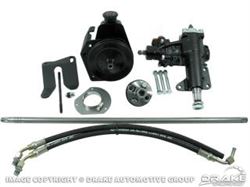Question:
Car was restored 3 years ago and driven lightly since then. I then purchased it and immediately found out the Power steering was messed up although everything under the front end was all new, nos, oem and or rebuilt to oem.
But the power steering is very quiet and does a great job as long as I am turning to the right. But I have to use both hands as if it were manual steering when turning it to the left. Parking or on the road. I have had it in 6 different shops and spent a ton of money on it and still like it was. It never makes any noises idling and or on road. What can be wrong with it and what do I get done to it to fix it. Last shop said to replace it all, Pump, Ram, drag-link and complete control-valve assembly.?????
Answer:
The control Valve: the control valve determines which side of the ram cylinder gets pressurized to retract the rod or extend the rod from the cylinder.
So there are two possible problems: the cylinder may have a bad seal that is allowing the pressurized side fluid to pass to the return side or the control valve is failing and a seal in there is letting pressurized fluid pass or is restricting pressurized fluid from getting to the ram cylinder.
Resources
If you where to replace the entire system you should consider one of these kits:
Power Steering Conversion Kit
http://mustangparts.averagejoerestoration.com/mustang-power-steering-conversion-kit-cid1603

The principals of power steering video
1961-1978 Bendix-style Power Cylinder
A basic working description of the Ford/Bendix style hydraulic Power Cylinder with attention to some of the model line differences and production variations.
BASIC CONSTRUCTION
The Power Cylinder is a construction of one tube inside another. One end of the Cylinder generally has a Stud mounted into it where the Cylinder connects to the Center link. This Stud can swivel on the Cylinder to allow for linkage movement and to prevent binding. Some Cylinders do not have a Stud but an Eyelet for bushings where it mounts to the frame of the car.
The other end of the Cylinder has a polished metal Rod coming out of it that attaches to a bracket mounted on the drivers side frame rail. The end of this Rod goes inside the inner tube of the Cylinder and has a Piston attached to its end. Where the Rod comes out of the Cylinder are a series of seals to contain the pressurized fluid inside and to seal out water and dirt from the outside. The Rod also has a corrugated, stretchable Accordion Boot to seal and prevent damage from moisture, rocks and dirt.
BASIC OPERATION
Fluid flows from the Control Valve to the two ports on the Cylinder. Depending on the flow from the Control Valve, one port is pressurized and the other acts as a return port. The pressurized fluid pushes against the Piston which moves the Rod in or out of the end of the Cylinder, depending on which side of the Piston is pressurized by the valve.
The Rod, which is mounted to the cars frame rail by a cast iron Frame Bracket, either pushes or pulls against the bracket. Since the Frame Bracket is securely mounted and does not move, the Cylinder itself moves toward or away from the bracket, moving the Centerlink with it. Moving the Centerlink moves the steering linkage which turns the wheels and steers the car.
Basically, the Cylinder, by extending or retracting the Rod, makes itself longer or shorter and pulls or pushes the steering linkage with it as it moves.



Why not recommend ADJUSTING the p/s control valve?
1971 MUSTANG LEFT TAILLIGHT HAS RUNNING LIGHTS, AND TURN SIGNALS, BUT NO BRAKE LIGHTS. RIGHT TAILLIGHT WORKS FINE. ANYBODY KNOW HOW TO FIX PROBLEM ?